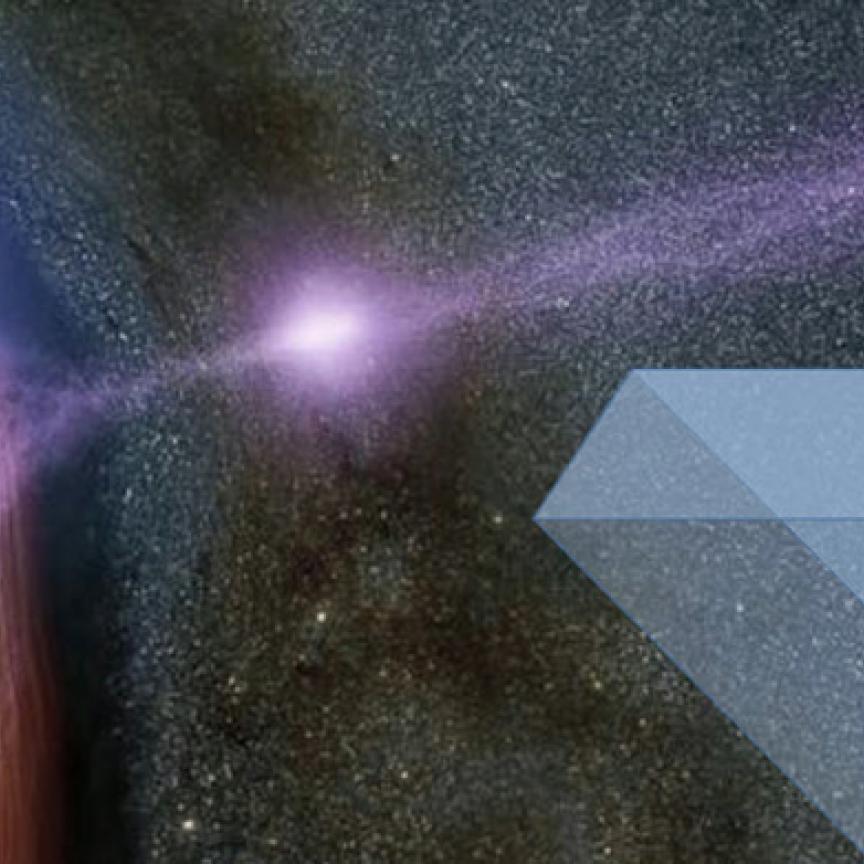Humberto Michinel and Ángel Paredes at the Optics Laboratory of the University of Vigo in Ourense, Spain, discuss optical approaches to studying ‘hidden’ energy
One of the most important open problems in contemporary physics is the nature of dark matter, which is known to form around one quarter of the total energy budget of the universe.
Novel experiments and astronomical observations are expected to shed new light on this question during the coming years. They should be able to provide evidence to confront observations with the numerous theoretical hypotheses that have been put forward concerning the dynamics, and the ultimate constituents, of dark matter.
Among these scenarios, a particularly interesting one assumes that the elementary dark matter particles are very light bosons that collectively behave as a wave that self-interacts gravitationally. It is mathematically described with the so-called Schrödinger-Poisson equation (SPE, sometimes also called Schrödinger-Newton or Gross-Pitaevskii-Newton equation), a model introduced long ago as a non-relativistic approximation to the dynamics self-gravitating scalar fields.
From the perspective of research in optics, this scenario provides an interesting opportunity. In fact, a number of remarkable experiments have been recently performed in order to mimic aspects of Newtonian gravitation in non-linear optical setups, opening the possibility of designing optical analogues of gravitational phenomena. Different versions of the non-linear Schrödinger equation, which are usually solved by means of computer simulations, are typically used for the description of laser light propagation in non-linear media. In particular, the SPE applies, among other situations, to the propagation of a laser beam in a thermo-optical material, namely one in which the refractive index depends on temperature. In this context, the Poisson equation appears naturally as a steady state heat equation.
Thus, the appearance of SPE in different frameworks is a mathematical coincidence that suggests that certain properties of dark matter behaviour should have an optical counterpart. For instance, solitons have been a subject of intense research during the past decades in the context of laser propagation in non-linear optical media. In an optical soliton, the interplay of diffraction, dispersion and non-linear optical properties of the materials gives rise to robust particle-like beams that can travel unlimited distances without any distortion in its shape. These ‘light bullets’ can also trap another light inside them, acting as light-guiding light structures, yielding an ever increasing control on light propagation and to deep connections to other areas of physics, light fluid dynamics or cold atoms. Their cosmic equivalent would be the existence of huge self-trapped dark matter solitons that constitute the core of typical galaxies, with sizes in the hundreds or thousands of parsecs. In a sense, they act as waveguides for the galaxies that are trapped in the zone of highest gravitational attraction. This situation is analogous to all-optical soliton waveguides that are well known in non-linear optics.
It is also intriguing to consider soliton collisions from this point of view. In optics, researchers are acquainted with the fact that solitons behave like robust objects but that, when they meet, interference plays a decisive role. The same mechanism might therefore be at play in galactic collisions. Since dark matter solitons are coherent waves, they can interfere constructively or destructively like laser beams in an interferometer. In the case of solitons behaving like robust clumps, destructive interference is analogous to an elastic collision between two particles that separate after hitting each other. It is important to notice that the meticulous observations of galactic clusters stand out among the most promising strategies for understanding dark matter. The displacements of the stars, with respect to the gas and dark matter, give information about the dynamics of the collisions. Interferential optical-like phenomena might result in detectable features that, in fact, might have already been observed.
This ‘dark matter optics’ approach can be applied to the study of other cosmic phenomena, such as the coalescence of solitons in relation to galactic mergers or the interactions between dark matter and supermassive black holes, which can be easily modelled as ‘dot potentials’. Similarly, modulation instability and filamentation may provide an optical analogue of cosmic structure formation.
Conceptually, it is certainly appealing that, albeit partially, the astrophysical and cosmological dynamics of dark matter can find an analogy in the spatial profiles of laser beams. Moreover, it is worth analysing this interdisciplinary connection, since usual notions or methods of optics might find application for dark matter or vice versa. We hope that this remarkable analogy will pave the way to performing tabletop photonics experiments that can mimic particular aspects of the behaviour of dark matter in an optical laboratory.
--
Submission is open for the EOS Optical Technologies, held as part of the World of Photonics Congress in Munich, from 24 to 26 June, including the sixth Conference on Manufacturing, Tolerancing and Testing of Optical Systems, and the fifth Conference on Optofluidics.


